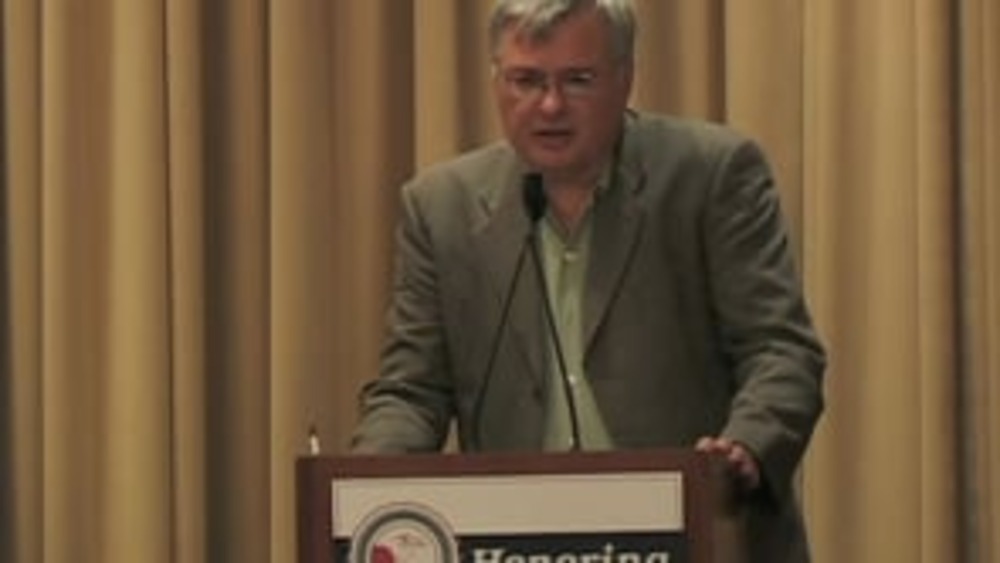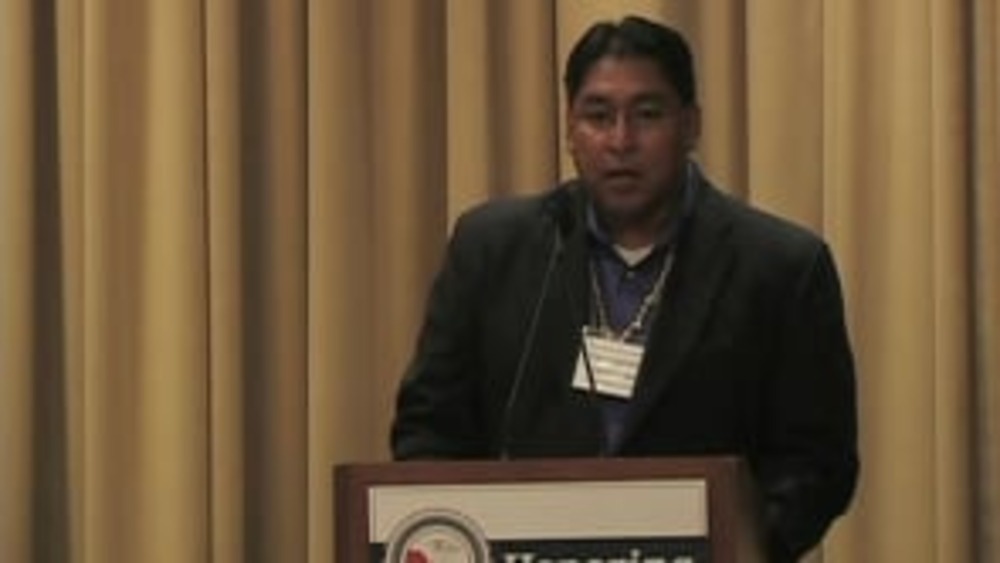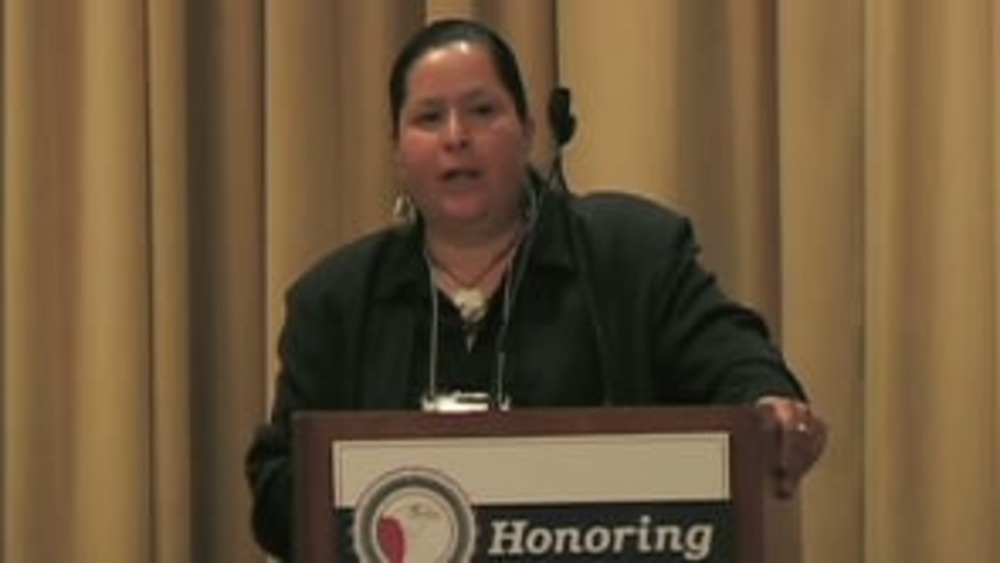Gabriel Lopez and Shannon Martin field questions from the audience about their nations' Honoring Nations award-winning programs.
Additional Information
Lopez, Gabriel. "Government-to-Government Relations (Q&A)." Honoring Nations symposium. Harvard Project on American Indian Economic Development, John F. Kennedy School of Government, Harvard University. Cambridge, Massachusetts. September 18, 2009. Presentation.
Martin, Shannon. "Government-to-Government Relations (Q&A)." Honoring Nations symposium. Harvard Project on American Indian Economic Development, John F. Kennedy School of Government, Harvard University. Cambridge, Massachusetts. September 18, 2009. Presentation.
Transcript
Joseph P. Kalt:
"Vice chairman Lopez, I'd like to ask you a question. We of course talked a minute and heard your stories. Does anyone not get along with you anymore? It seems like you're able to strike MOUs [Memoranda of Understanding] with the city, with the private developers. Where are you still having trouble, where are your current battle lines drawn?"
Gabriel Lopez:
"I think it's educating. We have a lot of non-Natives that move into the area. We had, in Arizona we had our dove season. Many times what happens is we have new people that come into the area, don't know where the reservation starts. We posted signs, tribal, state, federal laws, trespassing signs. I can go back out, I usually ride, I'm an avid horseback rider and I ride out there after the season's over and I'll find cuts. People will come in, ATVs will go into washes, will come in and try to ride all over. And we try to discuss that with the city and let them know [because] they have their own city website to voice our concerns. And by a joint venture we're starting to work on that now. But also with other developers that are coming into the area and trying to educate them and having them come to the -- as a consultation with the community -- to voice our concerns and what we want. And like I said, we really don't want to hamper growth, we know it's coming and we have to handle it, we have to deal with it. But bring us to the table so we can voice our concerns. I think maybe that's what -- and I think that's what's working. But there's still a lot to be done.
For instance, Roman and I were over at federal EPA [Environmental Protection Agency] when the presentation was done back in Arizona, we were still on the battlegrounds fighting with the EPA there. It's an ongoing process, and we just need to stay up on top of that. And as tribal leaders, because when there's only a five-member council, we can't possibly get to all of them, so a lot of times we kind of rely on our staff. We'll hear about it and that's how the task force came out."
Audience member:
[inaudible]
Duane Champagne:
"Oh, back there."
Charlie O'Hara:
"...remarks about, particularly about the EPA and I think the EPA has this stovepipe kind of funding by media, which is totally inappropriate for tribes. For, I don't know how many, 15 years we've been capacity building under GAP [General Assistance Program], but there's no mechanisms for implementation. It's a really outdated system and it has to be changed."
Duane Champagne:
"There's a question in the back."
Audience member:
"I do have a question but I do have a comment as well. You want to talk about how to take over and utilize your natural liberty to enforce your -- a watershed council is a good example of retaking responsibility for your environment and just doing what you need to do. It's a great example. I'm glad that Pat's here.
My question though is for Shannon. How did -- what was the strategy or the argument when people would come to you from the educated side, academia, and maybe try to pressure you that you didn't know what you were doing because you didn't have the letters behind your name?"
Shannon Martin:
"Well, we continue to nurture, first and foremost, those professionals that do have the letters behind their name and keeping those as close to us as we can through consultative relationships. Our curator William Johnson and I, again we were subjected to some serious scrutiny during, throughout the whole course of this process. And that, because we didn't have the scholarship behind us -- as far as best practice in anthropology, archaeology, 'any-ology' -- our concerns and our process in working through those ideas and those methods with our tribal community council and elders, they were at various points dismissed by city officials, by the Genesee County Land Bank, [because] we continued to advise them throughout this process as to what they needed to do to mitigate. We even provided legwork in giving them two bids for archaeological consulting crews -- to come in and take care of the damage -- with the tribe overseeing and monitoring. But again all of that, of course, was dismissed because of lack of funding from the City of Flint and from the Genesee County Land Bank.
The unfortunate situation with HUD [Department of Housing and Urban Development] -- who has been a friend to tribes across this country in providing adequate funding -- is that HUD was slippery in this situation. They were at the negotiating tables within the first couple of meetings of this disturbance, but then soon realized that once the tribal council had imposed a cease-and-desist order -- that was going to be adhered to by the city officials and the Genesee County Land Bank, the landowners -- HUD pulled out of the project. They slipped out of it on a technicality, stating that the funding that was earmarked for this project, which was essentially the pouring of the basements, the cement basements, because that part of the agreement had not been reached, they then pulled their funding from the project. So in doing so there were these, City of Flint and Genesee County Land Bank didn't have to comply with historic preservation laws. So the court -- the tribe had no recourse to count on national NAGPRA [Native American Graves Protection and Repatriation Act] for their support, but more importantly, the Advisory Council on Historic Preservation [ACHP] -- the Section 106 Law, which would directly implicate this process -- and HUD would have to provide funding to mitigate.
So the onus of all this coordination fell squarely upon the shoulders of the tribe. And an unfortunate situation is resulting in an unfortunate precedent-setting event. Because in doing so, and us addressing and putting together this proposal based on all of these individuals' tribal and archaeology consultants, and then the tribe bearing the responsibility to provide the funding for the mitigation, that precedence has been set in which -- we weighed that heavily throughout the process because we knew that on one scale was this precedence. On the other end of the scale was making sure we were respecting and doing what was culturally appropriate to take care of these ancestors at our cost. So now there are going to be some scholarly articles written on this, because the situation was just layered in complexity.
And we're fearful now, really, as a tribe that they're going to be private landholders. And if there is a federal undertaking that they're going to pull out of the project if there's an overt discovery. And who are they going to turn to be responsible to mitigate and to come up with a proposal to recover and rebury? The local tribe. And if that tribe doesn't have the resources that -- the Saginaw Chippewa fortunately has the resources to do this work -- that local tribe is going to have to possibly stand by and watch it just get bulldozed back in, without any respect or due process for the ancestral remains."
Josh Weston:
"Good afternoon everybody. My name's Josh Weston. I'm the chairman or the president for Flandreau Santee Sioux Tribe who we started out the session with. I had one general comment to make and then I've got a question for the cultural portion of it.
I just wanted to add a little bit about the educating the public, the being able and willing to work with your local governments both tribal and city, state and federal has been and is continuing, I'm sure for most tribes, an uphill battle. And as far as I'm concerned we continue to try to address some of those problems and work through our differences of opinion. We're kind of at a head road with our project. Our chief is leaving us; he's the only one of two, well, three now. One of our members finally made it onto the tribal police department and he's leaving to better himself. So it's going to be an interesting discussion on how we continue forward. And we hope that both communities can come to some agreement on how we can make that transition, one way or another.
The second part of the comment or the question I wanted to ask was, in our area we have a tribe to the south of us that is having, has had problems with non-members into burial sites and taking artifacts and removing of the remains and that sort, in that area. And part of the problem is that they can't do anything about it. They can't hold when they report. It's kind of in an area where there's a [Army] Corps of Engineers and there's that no man's jurisdiction -- the tribe doesn't have jurisdiction, the state really doesn't have any jurisdiction, the U.S. attorneys don't want to prosecute it because nobody's gotten hurt to a certain extent. So they kind of fall into that huge void of, 'Yeah, we have to protect these people without hurting them and letting them take our remains away from those sites,' and then trying to go after them afterwards for bringing them home. So I was just wondering, had you had any experience with any type of that jurisdictional problem when it comes to -- do you have any -- was there any federal land in there where you kind of had some of these problems? And maybe if you could talk about that a little bit."
Shannon Martin:
"Not in relationship to burial site desecration on federal or state land, but we are currently addressing a sacred site that is state land. Because like many other states in the union, Michigan is [experiencing a] lack of resources and capital to maintain certain state parks. And there is a state park that is managed by three agencies, that's the Department of History, Arts and Libraries, the Michigan Museum Association and the Department of Natural Resources. The sacred site is the Sanilac Petroglyphs and it falls within the historic territory of the tribe. We have been carefully and diligently monitoring the site because it has fallen into neglect. Individuals are making their way into this petroglyph site that at one time contained over 300 distinct teachings or cultural etchings in our language, we call it [Anishinaabe language], which is 'teachings on stone.' These petroglyph carvings have been altered, they've been literally bore out of the sandstone site, out of the rock itself, and have been taken away. And we've been beginning to more urgently address this issue and insert ourselves, to call these agencies together and meet with us in tribal council, to place on the table, a management plan and/or a plan for them to turn this 274 acres, that contains the site, over to the tribe if need be. So we've been trying to compel them to, 'Let us manage it, let us take care of it. We have the resources -- and/or sell it to us at a fair price. Let's buy it and take care of it.' So that's one issue that we're currently working on because the site is so significant to the cultural and collective history of the Anishinaabe people of the Great Lakes region. And the tribe is taking -- through our work at the Ziibiwing Center -- these proactive measures to begin calling together these different agencies and really trying to compel them to turn the management over.
And we're beginning to, we are going to work with Dr. Sonya Atalay, an Ojibway archaeologist out of Indiana University through a program, a project, a grant project called IPINCH, which is the Intellectual Property Issues and Cultural Heritage project, and it's an international multi-disciplinary grant that is being administered through Simon Frasier University in British Columbia. And our project specifically addresses the long-term plan and management of the Sanilac Petroglyphs, so that we can protect it and we can monitor it so that it doesn't fall under disrespect, vandalism and neglect. But as far as desecration of burial sites, that's something we haven't encountered on federal or state land, just private land."
Duane Champagne:
"Do we have any more comments? Here. Oren, in front here."
Oren Lyons:
"I want to make a comment on your opening statement about the wampum and protocol and governance. Rick Hill, from Tuscarora, has been doing a research project and is now into three volumes of transactions using wampum, the first 400 years here. And just to add some information to you that First Continental Congress, John Hancock, one of his first duties was to make a wampum belt. And that was the belt that he used for peace and neutrality. As they were getting ready to fight one another, we being the Six Nation Iroquois said, 'Well, look, we know your father and we know you.' And, 'Look at this as a fight, the father and son.' And, 'We don't think it's appropriate for us to be in on one side or the other.' And they said, 'Thank you, because that was going to be our second request. If you don't fight with us, don't fight against us.' And so that belt was made by John Hancock, as one of his first duties as president of the Continental Congress. And later George Washington also made a belt, 1794 Canandaigua Treaty, called the George Washington Covenant, is about a six-foot wampum belt with the thirteen colonies; and also...from our position, peasant from his position. And I just want to add that on because, just, if you think about it, here we are -- 1794, well into the new United States -- and they are still using wampum as protocol."
Duane Champagne:
"Thank you."



